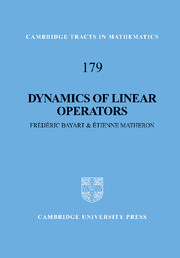Book contents
- Frontmatter
- Contents
- Introduction
- 1 Hypercyclic and supercyclic operators
- 2 Hypercyclicity everywhere
- 3 Connectedness and hypercyclicity
- 4 Weakly mixing operators
- 5 Ergodic theory and linear dynamics
- 6 Beyond hypercyclicity
- 7 Common hypercyclic vectors
- 8 Hypercyclic subspaces
- 9 Supercyclicity and the Angle Criterion
- 10 Linear dynamics and the weak topology
- 11 Universality of the Riemann zeta function
- 12 An introduction to Read-type operators
- Appendices
- References
- Notation
- Author index
- Subject index
6 - Beyond hypercyclicity
Published online by Cambridge University Press: 10 December 2009
- Frontmatter
- Contents
- Introduction
- 1 Hypercyclic and supercyclic operators
- 2 Hypercyclicity everywhere
- 3 Connectedness and hypercyclicity
- 4 Weakly mixing operators
- 5 Ergodic theory and linear dynamics
- 6 Beyond hypercyclicity
- 7 Common hypercyclic vectors
- 8 Hypercyclic subspaces
- 9 Supercyclicity and the Angle Criterion
- 10 Linear dynamics and the weak topology
- 11 Universality of the Riemann zeta function
- 12 An introduction to Read-type operators
- Appendices
- References
- Notation
- Author index
- Subject index
Summary
Introduction
In this chapter we study some variants of hypercyclicity. First, we show that a Banach space operator T is hypercyclic provided that every point of the underlying space stays at a bounded distance (not depending on the point) from some fixed T-orbit. Then, we consider two qualitative strengthenings of hypercyclicity, namely chaoticity and frequent hypercyclicity. We point out several interesting similarities and differences between hypercyclicity and these two variants. In particular, any rotation and any power of a chaotic or frequently hypercyclic operator has the same property; however, chaotic or frequently hypercyclic operators cannot be found in every separable Banach space. Moreover we show that frequently hypercyclic operators need not be chaotic, and we construct an operator which is both chaotic and frequently hypercyclic but not topologically mixing.
Operators with d-dense orbits
Given a Banach space X and d ∈ (0,∞), we say that a set A ⊂ X is d-dense in X if, for each x ∈ X, one can find z ∈ A such that |z – x| < d. The following interesting theorem is due to N. S. Feldman [107].
THEOREM 6.1 Let X be a separable infinite-dimensional Banach space, and let T ∈ L(X). Assume that T has a d-dense orbit for some d ∈ (0, ∞). Then T is hypercyclic.
PROOF We first observe that if T has a d-dense orbit for some d then in fact it has an ∈-dense orbit for any ∈ > 0.
- Type
- Chapter
- Information
- Dynamics of Linear Operators , pp. 134 - 163Publisher: Cambridge University PressPrint publication year: 2009

